| 1 | The 4th or 5th largest snake |
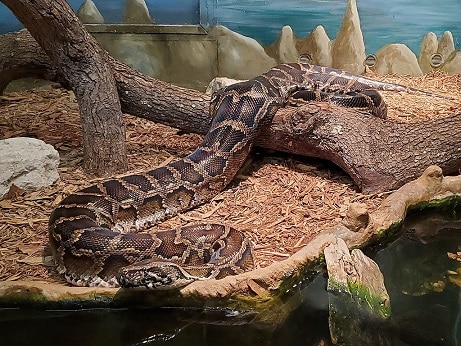
The Burmese python is one of the most powerful, crushing snakes in the world. This species is native to Myanmar, Bangladesh, Thailand, Cambodia, and extreme northeast India, where it lives in marshy areas and wetlands. Burmese pythons are part of the true python family (simply titled Python), and rank among the 5 longest snake species surviving. The longest wild individual measured 5.79 metres, and the longest captive specimen 5.74 metres, a female called Baby living at Serpent Safari in Illinois.
Originally, Burmese pythons (Python bivittatus) belonged to the same species as the Indian python (Python molurus), but genetic testing led to a split in 2009. The two slightly differ, as Burmese pythons are larger and slower, and prefer semi-aquatic habitats like marshes. Indian pythons are smaller and faster, and prefer drier areas.
The heaviest recorded snake of all time was a Burmese python – Baby weighed 403 pounds at her peak. While reticulated pythons reach longer lengths, Burmese pythons are exceptionally thick, with such crushing constricting force that they could crack open the toughest Wall Street safe.
More notoriously, the Burmese python has become an invasive snake in the Florida everglades, which has proven impossible to eradicate.
| 2 | Florida’s invasive nightmare |
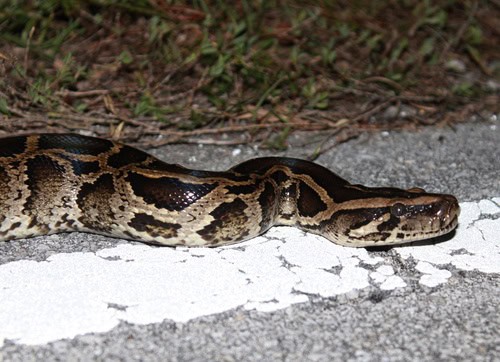
There are no native pythons in the western hemisphere, yet the Burmese python is now estimated to number at least 100,000 in the Florida everglades, and perhaps up to 1 million. The everglades cover the lower 3rd of Florida, reaching 30 miles from Miami. They’re totally uninhabited by humans, with just two major highways crossing them, the 9336 and Highway 41.
While the everglades cover just 25% of their original range, a huge swathe is protected in Everglades National Park. This is inhospitable land for humans, and is ruled by alligators, wading birds, turtles, and marsh rabbits. But the Burmese python has invaded this realm, and the first Florida sightings date back to the 1930s. In the 1980s, the trend for imported pet snakes accelerated, and Miami became the national hub for trading exotic creatures.
As the world’s 5th largest snake, many owners become overwhelmed when their pet Burmese python ballooned to 3 metres, and released them into the wild. It’s believed that the category 5 Hurricane Andrew opened the floodgates, as Florida’s worst ever storm destroyed a python breeding factory in 1992, setting the inhabitants loose. By then, the Burmese pythons had reached the minimum viable threshold for breeding.
| 3 | Population: potentially up to 1 million |
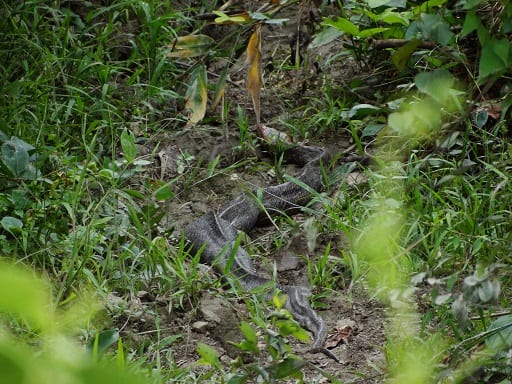
As of 2024, Burmese pythons are more numerous than ever. Like any invasive species, they’ve had damaging effects on the ecosystem, particularly on native mammals. Between 1997 and 2012, numbers of raccoons plummeted by 99.3%, opossums plummeted by 98.9% and bobcats plummeted by 87.5%.
In one experiment from 2013, scientists released endangered marsh rabbits in the everglades, equipped with radio trackers. Of those that died within the first 11 months, 77% ended up in the coils and jaws of a Burmese python. American alligators, meanwhile, are both their predator and prey, depending on age.
A multitude of factors combine to make Burmese pythons nearly impossible to eradicate. Burmese pythons have such exceptional camouflage that humans fail to spot them while they’re just 6 feet away (see the image above). They naturally retreat to burrows and thick swampy vegetation when inactive, and then there’s the sheer vastness of the Florida everglades. Not only are they enormous, but very difficult for human hunters to navigate, even lured on by the promise of a bounty. As a national park, there’s no development, no convenient sidewalks. You’re wading through mud and marsh where there’s a fear of alligators around every corner.
| 4 | Constantly respawning |
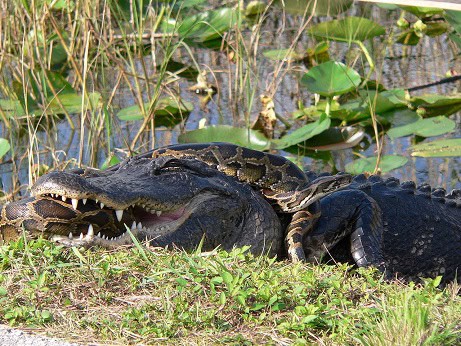
Burmese pythons have survived so well because the everglades are the ultimate mimic of their natural Myanmar marshland habitat. It’s like the species’ own holiday resort 10,000 miles away, just as Florida is a holiday hub for humans. Mother Burmese pythons are also exceptionally prolific, laying an average of 20-50 eggs and an all-time record of 111. While they have a few predators, including alligators, these aren’t sufficient to restrict their numbers. Additionally, the local mammals had no fear of giant constricting snakes, which don’t exist in Florida naturally.
The invasion has led to some insane sights. Burmese pythons can open their jaws 4 times wider than their skull, due to stretchy connective tissue between the cranium and lower jaw. In 2022, scientists found a 5 foot alligator inside a 18 foot python, with the gator barely having digested. With its scales, teeth and cunning grin intact, it looked like it could have awakened at any moment.
In 2005, two rangers in Everglades National Park came across a gruesome sight, a mass of scales and skin and jaws. Investigation revealed that a Burmese python had attempted to swallow an alligator too large for it, and exploded, resulting in the death of both.
| 5 | Is genetic warfare the answer? |
Many methods have been proposed to deal with pythons. Ideas include bioengineering, by introducing a virus specific to Burmese pythons, to decimate the population as it spreads between them. But viral manipulation is imprecise and could accidentally spread to native snake species. Another purely theoretical scheme is DNA manipulation, editing the genome of a captive Burmese python and releasing it into the everglades. After spreading naturally, the gene could cause all offspring to become infertile, all offspring to become male, or something else that would guarantee the population’s extinction.
In 2021, scientists captured footage of a bobcat stumbling across a Burmese python nest and begin devouring the eggs. It even cached some of the eggs and returned days later for leftovers. Burmese pythons have reduced bobcat numbers – restoring them may be an answer.
Whether Burmese pythons could expand beyond Florida is heavily debated. Some scientists believe that if unchecked, they could occupy the entire southeast coast through Texas. Other models suggest that southern Florida and far southern Texas are the only climates suitable for them. During exceptional cold snaps in Florida, flooding in from the Arctic northeast, scores of dead snakes have turned up in the everglades.
| 6 | Sniffer dogs join the fight |
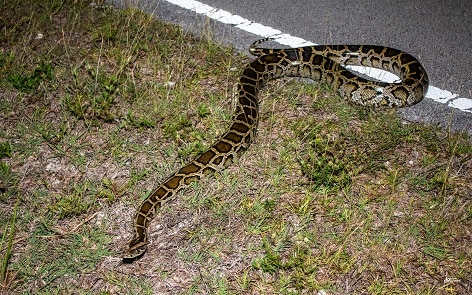
Some have proposed reintroducing the extinct Florida jaguar, as jaguars in South America regularly prey on anacondas. Sniffer dogs have been attempted too. Initially, a study found a success rate only slightly higher than humans, at 73% versus 69%. Dogs struggled with the everglades terrain just like humans.
But 2020 finally saw a breakthrough in the dog sniffer program, in the form of Truman the black Labrador and Eleanor the point setter. The dogs were trained for one month using python scented towels and live pythons injected with radio transmitters. The dogs were also trained on how to alert their human handlers, and on ignoring distractions like other animals while in the hunt.
Burmese pythons can be vicious, and Truman and Eleanor were trained to stop 3 feet away. On December 8th 2020, they officially had their first success, capturing an 8 foot Burmese python in Miami-Dade County. While this was just one python, it accomplished one huge feat: proving that it was possible, that dogs can assist the clean up of the everglades.
| 7 | The annual python festival |
In 2013, Florida’s government turned to old fashioned methods. They announced the first ever python hunt, open to members of the public, set to commence on January 12th 2013. Anyone could enter, and 1600 hunters flocked in, some experienced marksmen, some not so much.
Participants were instructed to shoot the Burmese pythons in the head with a shotgun, to kill them humanely. After 1 month passed, they killed just 68 pythons, making barely a dent in the 300,000 estimated to be roaming the Everglades. If the pythons knew of the plan, they’d surely be laughing collectively in our faces. But this was deemed successful for a first effort, and in 2016 the scheme returned, lasting from January 16th to February 14th.
This hunt was an improvement, at 106 Burmese pythons killed. Daniel Moniz won first prize for an individual by capturing a 13ft, 8.7in python, but suffered bites to the neck, arm and face in the process. Moniz had been laid off from his construction job, and spent the entire month biking 40 miles a day through the everglades, capturing 13 pythons. The team first prize was captured by Bill Booth’s gang, scooping up a 15 foot python.
| 8 | The python empire gets dented slightly |
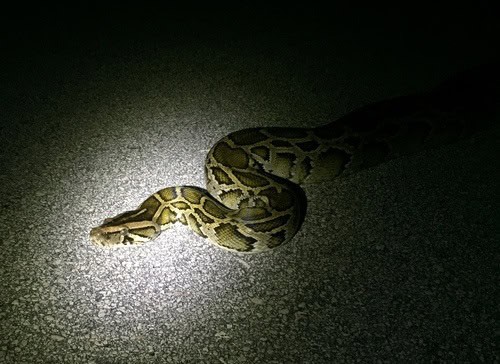
In 2020, the python challenge returned in a 10 day form, and has since become an annual event. While Burmese pythons are still firmly in control of the everglades, every year has seen higher tallies. 2022 saw a record, with 231 Burmese pythons captured by participants from the United States, Canada, and finally Latvia. 2023 saw a slight decline, but 203 pythons were still destroyed by 1050 participants (meaning that well over 800 failed to capture one).
While the totals seemed small against 300,000, the organisers were optimistic that the benefits could be disproportionate if those captured were females capable of breeding.
The Ultimate Grand Prize Winner was Paul Hobbs, who killed 20 Burmese pythons and received $10,000. There’s two separate awards for most pythons killed and longest python captured, and each category is further divided into 3 awards: military, professional and novice. All participants are required to complete a 10 day training course.
The phenomenon has led to people cooking python meat over a fire and serving it to their mates, but the Florida government strongly advises against this due to mercury contamination. When python tails were tested, this toxic heavy metal averaged at 3.5ppm, breaching Florida’s safe limit in fish of 1.5mcg.
| 9 | Baby the giga-python |
Like any massive constrictor, there’s many unsubstantiated figures floating around for the record length, some of which may be based in fact, but with the original source becoming buried over time. 7.62 metre Burmese pythons have been mentioned, or even 8.23m.
Until 2023, Baby held the official verified record. A resident of Illinois’ Serpent Safari, she first came to public attention in 1994 in an article in the magazine Reptiles, where her handler Lou Daddono proudly stated her to be 20 feet. In 2000, a new article in Reptiles featured Baby, in which Daddono now gave her length as 7.62 metres. In 1998, a team from Guinness World Records visited Serpent Safari and found Baby to weigh a whopping 403 pounds, which is possible given how heavily captive pythons can feed in comfortable captivity.
By 2009, Baby was dying due to complications from a metastatic renal tumor, having lost over 100 pounds. She was euthanised in the zoo’s veterinary office, then stretched full length down a hallway and measured with a steel tape by visiting scientists. The official measurement was 5.74 metres (18ft 10in).
At nearly 27, Baby was close to the oldest Burmese python ever. This record was held by a captive at San Diego Zoo which died at 28 years, 3 months and 5 days.
| 10 | July 2023: a new length record |
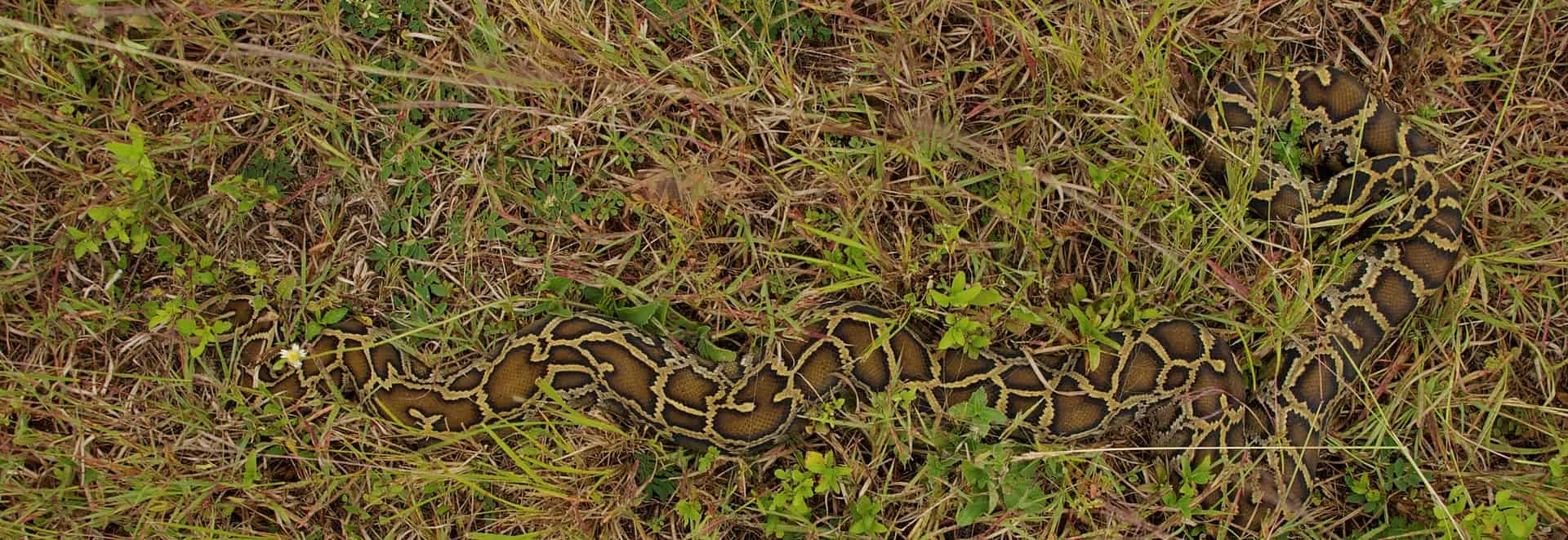
Baby held the record for many years, but on July 10th 2023, a new all-time record became official: a 5.79 metre Burmese python captured in Big Cypress National Preserve. It was caught by 22 year old Naples resident Jake Walleri, who devoted his nights to wiping out the invasive species.
The video begins with the giant python lunging at Wallari on a road at night. Walleri instantly seizes the python’s neck, then falls over and begins to wrestle his foe on the tarmac. The Burmese python attempts to apply its crushing coils, and appears to be making progress until Walleri’s friend arrives to pull it away.
Surprisingly, the python was relatively light at 125 pounds. It wasn’t bulky, but this made it look all the longer. The heaviest ever caught was a female in 2022 which weighed 215 pounds.
The python’s mouth was taped shut, and she was eventually killed and donated to science. No permit is required to kill a Burmese python according to Florida law, but they’re still subject to anti-cruelty laws, and must be killed humanely.
As of 2024, no decline has been observed in Florida’s invasive Burmese pythons, but optimism is growing, as more and more schemes prove to be moderately successful.
